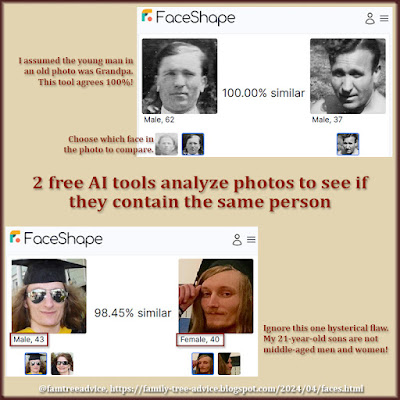Note: This article originally discussed 2 websites, but, sadly, FaceShape has shut down.
How many times have you wondered if the person in two different photos is the same person? Let's say you have a photo of your great grandfather as an old man. Then you find a photo that may or may not be him as a young man. How can you be reasonably sure the 2 photos show the same person?
I've seen people post photos like this on Facebook and let strangers weigh in. Are the eyebrows the same shape? Is the jawline dramatically different? Logic may help you figure out who the person is, but now we can do better.
Why not let a bit of artificial intelligence give you a scientific analysis of the 2 faces? I found 2 free websites that can help you decide who it is you're looking at. (If the photo is in bad shape, consider doing some photo restoration techniques before you use the comparison tool.)
 |
| 2 free tools compare faces in different photos for similarities. Find out if that old photo really belongs in your family tree with these helpful genealogy tools. |
Face Comparison
Go to https://facecomparison.toolpie.com to upload 2 photos from your collection. A message on the page says, "The model will delete the photo after the comparison is completed, so it is safe and reliable to use."
I uploaded 2 photos of my Grandma Lucy, taken several years apart, to see what would happen. Face Comparison says the 2 images of Lucy are 80% similar, so it's the same person. In fact, 80% is the threshold the site uses. Anything less than 80% is not considered to be the same person.
When I uploaded 2 photos of myself from 1986 and 2019, it was 100% sure they were the same person. So it's true when an old friend says you haven't changed a bit!
Then I threw it a curve ball. I uploaded college graduation photos of my 2 sons. Face Comparison says the boys are 78% similar, and they're not the same person. I'm sure they would agree.
FaceShape (This site had to shut down in 2025!)
Go to https://www.faceshape.com/face-compare to try the FaceShape comparison tool. FaceShape warns that it may keep your photos for machine-learning purposes. I imagine some people won't like that idea and would prefer not to submit their photos.
FaceShape says the 2 photos of my grandmother are 100% similar, so they are the same person. Since they are both, in fact, Grandma Lucy, I'm liking FaceShape better than Face Comparison.
It's also 100% sure the 2 photos of me are the same person. In one photo, I'm young with brown hair and firm skin, and in the other, I have white hair and not-so-firm skin. When it compares the 2 photos of my sons, it says they are 98.45% similar. I really got a kick out of that because when son #2 was born, he was identical to newborn son #1.
One odd feature about this site is that it identifies each photo as male or female and gives an approximate age. That's great in theory, but it thought Grandma was a man, and that I was 62 years old when I was actually 27! It identified my sons, both 21 at the time, as male, 43, and female, 40. Both boys had very long hair, but the one with the thin beard and mustache got the female label. It's best to ignore that aspect of the tool.
On FaceShape, if you upload a photo with more than one face, you can choose which face to compare. That doesn't work with Face Comparison. FaceShape also shows you both photos while Face Comparison never displays your photos.
For more fun, be sure to click the "Explore more tools" button. You'll find a host of other facial recognition tools. These include celebrity lookalike, face morph, face editor, and more.
 |
| Can you recognize your old grandmother in her childhood photo? These 2 free tools can do it scientifically. |
Giving Them Both a Real Test
I'm lucky to have my late aunt's photo collection, many of which were actually my Grandma Lucy's photos. (See My Aunt's Photos Tell the Other Side of the Story.) I have some photos I assume are Grandpa, but what do these face comparison tools think?
The old photo in question is from the 1920s and Grandpa was born in 1902. I decided to compare that young face to Grandpa at age 86. FaceShape finds an 82.30% similarity between the two. Face Comparison has to have only one person in the photo, so I cropped my photos and tried again. Unfortunately, this tool sees only a 58% similarity between the young man and Grandpa.
To make things easier, I compared the 1920s face to a photo I know is Grandpa in his 30s. Face Comparison found only a 78% similarity, but FaceShape says they're 100% similar. One hundred percent!
Based on my 4 tests, I prefer the FaceShape tool. I can overlook the fact that almost all of its gender and age labels were laughably wrong.
Take a look through your photo collection. Then use Face Comparison's AI tools to confirm that someone is who you suspect they are. Or see just how much you take after your ancestor.

